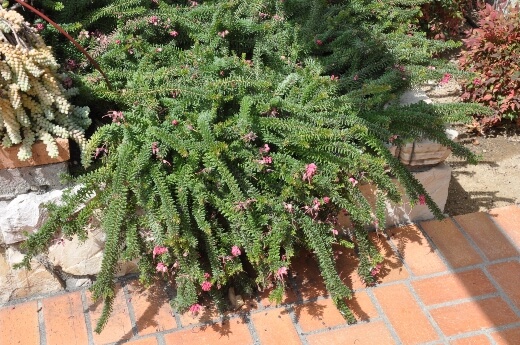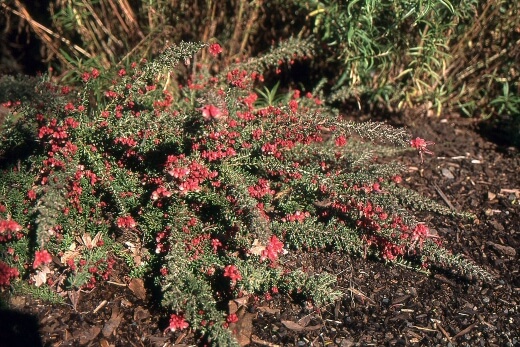Grevillea lanigera is a picturesque and playfully prostrate shrub that features clusters of pink to red flowers with cream-coloured accents from winter to spring, boasting spot flowering throughout the year as well.
I have a huge affinity for natives that can provide exceptional beauty while being easy to care for and this species is certainly up there. The abundance of long-lasting flowers can easily brighten up any garden, regardless of size.
In this article, I will be detailing how you can grow and care for this spectacular grevillea species in your garden.
More...

Source: PlantMaster
Family: | Proteaceae |
|---|---|
Genus: | Grevillea |
Species: | G. lanigera |
Common Name: | Woolly Grevillea |
Origin: | Australian Native |
Location: | Outdoor |
Type: | Shrub |
Growth: | 0.5 to 1.5 metres tall and wide |
Sun requirements: | Full sun to light shade |
Foliage Colour: | Green |
Flower Colour: | Pink to red with cream |
Flowering: | Winter to Spring (with spot flowering year-round) |
Maintenance level: | Low |
Poisonous for pets: | Can be mildly toxic if consumed in large quantities |
Introducing Grevillea lanigera
Apart from its beautiful blooms, this species features luscious evergreen foliage and narrowly oblong and hairy dark green leaves amidst its flowers. Enjoy this highly variable, spreading grevillea in almost any spot in the garden.
Scientifically labelled Grevillea lanigera, the plant's common name is Woolly Grevillea. It is native to south-eastern continental Australia where it thrives in moist rocky places in woodlands and forests.
After years of adaptation and cultivation, this species can be grown in a variety of habitats but is not suited to humid or tropical climates. Considered fast-growing, this shrub will typically reach 0.5 to 1.5 metres tall and wide.
It makes for excellent Grevillea ground cover as it forms a dense mat but it can also be used in mass plantings or as a specimen along borders or in rock gardens. A popular yellow flowering cultivar is the Grevillea lanigera ‘Lutea’.

Source: The Native Shop
How to Grow Grevillea lanigera
This species can be reliably propagated by seed or using cuttings. Seeds should be nicked with a sharp knife before sowing to improve germination. Sow in a quality seed-raising mix and keep in a warm sheltered location.
Alternatively, use firm semi-hardwood cuttings from the current season's growth and they should strike reliably. Plant in a quality potting mix and keep lightly moist at all times.
Ideal Conditions for Planting Woolly Grevillea
Grevillea lanigera is hardy in a range of climate and soil conditions.
Sunlight
It certainly prefers sunny positions in the garden but can tolerate lightly shaded conditions as well.
Soil
While this shrub can tolerate a wide range of soil types, good drainage is essential. In gardens, it prefers moist sandy to medium loam soil.


Get Your Free Guide:
Master Growing Australian Natives eBook
A Must Have Complete Guide for Every Australian Garden
Get Your Free Guide:
Master Growing Australian Natives eBook
A Must Have Complete Guide for Every Australian Garden
Grevillea Lanigera Care Tips
This species is drought and frost tolerant once established.
Watering Needs
Once established, Grevillea lanigera along with its cultivars require little to no extra water. On average, water once every 2 to 3 weeks to keep the soil lightly moist.
Fertilising
While not necessary, this plant can benefit from being fed with a low phosphorus fertiliser in spring to encourage more spot flowering throughout the year.
Pruning
Tip prune from a young age to encourage a dense and bushy habit. Then, prune after the main flush of flowers yearly. It is best to regularly tip prune than hard prune this plant.
Caution: This species can cause skin irritation in some people. Wear protective gardening gloves if needed when handling the plant.
Pests and Diseases
Woolly grevillea is pest and disease resistant. Overwatering can lead to root rot.
Grevillea lanigera Frequently Asked Questions
Can Grevillea lanigera grow in shade?
Full sun to partial shade is preferred. This species may struggle in very shaded conditions.
What is the common name of Grevillea lanigera?
The other very common name for Grevillea lanigera is the Woolly Grevillea.
Where does Grevillea lanigera come from?
This species is endemic to south-eastern continental Australia, occurring largely from northern Victoria to the south coast of New South Wales.
Don’t miss our main Grevillea post to discover more varieties to choose for your garden.
Add Lively Lusciousness to Your Garden with Grevillea lanigera
I believe this is the perfect grevillea species if you’re looking for a vivid and low-growing shrub. With its brilliant, long-lasting blooms and textured evergreen foliage, Grevillea lanigera can impress and add a lively influence to any garden year-round.
Published on May 26, 2023 by Nathan Schwartz
Last Updated on February 23, 2025





